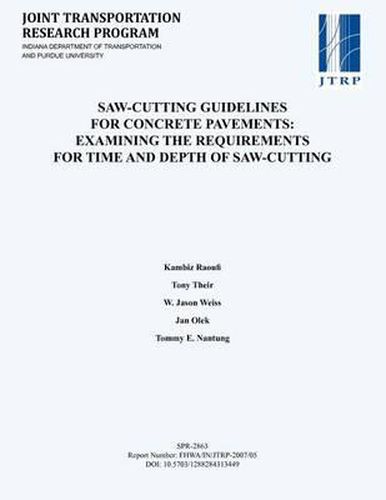Readings Newsletter
Become a Readings Member to make your shopping experience even easier.
Sign in or sign up for free!
You’re not far away from qualifying for FREE standard shipping within Australia
You’ve qualified for FREE standard shipping within Australia
The cart is loading…






Joints are placed in Portland cement concrete pavements (PCCP) to control random cracking. These joints provide a weakened plane that enables a crack to form in a controlled manner, relieving residual stresses that develop when thermal, hygral, or hydration movements are resisted by sub grade and adjoining pavement. While the concept of creating a weakened plane through saw-cutting is straightforward, determining the time and depth of the saw-cut has proven to be complicated. The goal of this project was to reduce the risk for joint raveling and random cracking. Specifically, this project has focused on: developing a procedure for determining the appropriate saw-cutting time window for typical pavements constructed in the state of Indiana, determining the depth of the saw-cut that minimizes the risk of micro-cracking and random crack development, and developing tools and training materials for paving contractors and state inspectors that aid in implementing the findings of this study in concrete pavements. Toward this end the project was divided into three phases. The first phase of the project consisted of shadowing five pavement projects in Indiana. The second phase of this work the development and commissioning of a new tensile wedge testing approach to determine the early age properties of concrete. Finally, finite element simulations were performed to simulate the early-age behavior of pavements constructed under a variety of saw-cutting sequences and environmental conditions. A strength reduction factor was computed based on the depth of the saw-cut. It was shown that the time of the saw-cut introduction needs to occur before the residual stress divided by the product of the strength reduction factor and tensile strength was equal to unity. It was also shown that shallower saw-cut depths were more prone to construction and material property variability.
$9.00 standard shipping within Australia
FREE standard shipping within Australia for orders over $100.00
Express & International shipping calculated at checkout
Joints are placed in Portland cement concrete pavements (PCCP) to control random cracking. These joints provide a weakened plane that enables a crack to form in a controlled manner, relieving residual stresses that develop when thermal, hygral, or hydration movements are resisted by sub grade and adjoining pavement. While the concept of creating a weakened plane through saw-cutting is straightforward, determining the time and depth of the saw-cut has proven to be complicated. The goal of this project was to reduce the risk for joint raveling and random cracking. Specifically, this project has focused on: developing a procedure for determining the appropriate saw-cutting time window for typical pavements constructed in the state of Indiana, determining the depth of the saw-cut that minimizes the risk of micro-cracking and random crack development, and developing tools and training materials for paving contractors and state inspectors that aid in implementing the findings of this study in concrete pavements. Toward this end the project was divided into three phases. The first phase of the project consisted of shadowing five pavement projects in Indiana. The second phase of this work the development and commissioning of a new tensile wedge testing approach to determine the early age properties of concrete. Finally, finite element simulations were performed to simulate the early-age behavior of pavements constructed under a variety of saw-cutting sequences and environmental conditions. A strength reduction factor was computed based on the depth of the saw-cut. It was shown that the time of the saw-cut introduction needs to occur before the residual stress divided by the product of the strength reduction factor and tensile strength was equal to unity. It was also shown that shallower saw-cut depths were more prone to construction and material property variability.